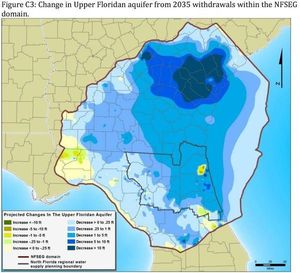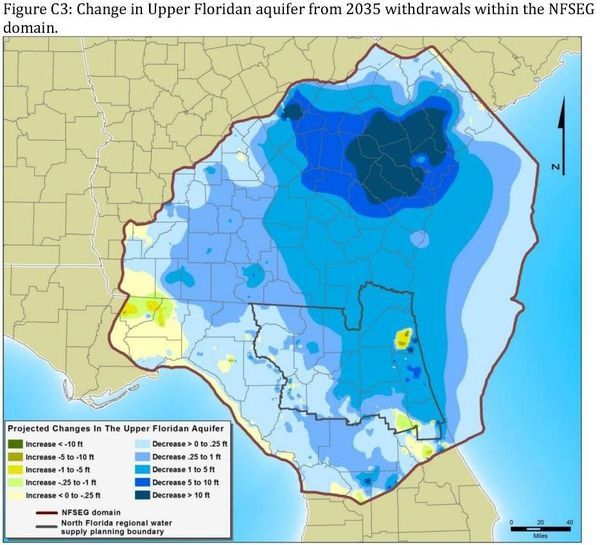FOR IMMEDIATE RELEASE
Jasper, Florida, November 6th 2016 — Better modeling and measurement of more water reuse and retention with fewer water withdrawals in both north Florida and south Georgia, WWALS Watershed Coalition (WWALS) recommended yesterday in comments (PDF) on the North Florida Regional Water Supply Plan (NFRWSP). WWALS also opposed the Falling Creek Aquifer Storage project and suggested a replacement, and recommended including threats to the FLoridan Aquifer and the Suwannee, Withlacoochee, and Alapaha Rivers such as pipelines and fracking.
 WWALS applauded water supply projects involving reuse or stormwater,
especially those in Jacksonvile and Gainesville, two of the sources of the
general problem of falling water levels in the Floridan Aquifer.
WWALS also applauded the plan to set minimum flow levels on the upper Suwannee River and WWALS expects to be involved with that.
WWALS applauded water supply projects involving reuse or stormwater,
especially those in Jacksonvile and Gainesville, two of the sources of the
general problem of falling water levels in the Floridan Aquifer.
WWALS also applauded the plan to set minimum flow levels on the upper Suwannee River and WWALS expects to be involved with that.
WWALS recommended expanding the original study area, which stopped at the Suwannee River on the west and the Georgia-Florida state line on the north. WWALS president John S. Quarterman explained,
“Our rivers don’t stop because there’s a state line on a map, and there are three second-magnitude springs on the Withlacoochee River in Georgia south of Valdosta, one of them with a more than 4,000-foot cave system, that aren’t taken into account in this draft plan.”
Quarterman elaborated on a much larger concern:
“When Jacksonville or Gainesville (or Orlando or Savannah or even Valdosta) extracts groundwater, that changes the flow over the much larger North Florida Southeast Georgia (NFSEG) area some maps in the Plan show reaching as far as into South Carolina. That whole area needs to be modeled and calibrated with real-world data, and the people and organizations of that whole area need to be consulted.”
WWALS recommended some modeling approaches and more extensive peer review and public comment.
Since no models are worthwhile without real data, WWALS recommended regular water quality monitoring of the rivers in Florida and Georgia, in addition to flow levels and well monitoring, since surface water interchanges with groundwater.
Such monitoring will help distinguish sources of contamination, such as the chronic Valdosta wastewater overflows now mostly solved, excretions of wild, farmed, or domestic animals or humans, or agricultural fertilizer or pesticides.
That would include determining the effects (if any) of the recent massive consolidation of agricultural lands in a few hands in the NFSEG area.
About the controversial plan to extract water from the Suwannee River near White Springs and ship it eastwards to a sink in Falling Creek, WWALS wrote:
“The Falling Creek project has very large up-front expense, involves environmental risk in running a large-diameter pipe through wetlands, and has high maintenance cost. In addition it only benefits the Ichetucknee Springs watershed. It is seasonal, for instance at the water levels now in the Suwannee, there is no water to pump to Falling Creek.”
Regarding the wider NFSEG study area and lowered Aquifer levels far from the original study area, WWALS remarked:
None of the projects address that problem in any significant way. Much of the area in Florida that has lost that water in the Floridan is below Columbia, Hamilton, and Baker Counties.
WWALS didn’t stop at criticizing; it offered a solution, involving forestry management:
WWALS recommends the much more practical and cost-effective plan Dennis J. Price P.G. has already submitted to SRWMD and NFRWSP.
Dennis Price wrote in his gravity-driven low-maintenance drainage-well proposal:
The area proposed for this project is located over the Floridan where significant lowering of groundwater levels have occurred over a very large area. The most efficient way to recharge large areas is by constructing drainage wells. In the attached map, the major wetland systems have a drainage-well constructed in a location that is accessible and, is located, where the wetland system begins to narrow down.
WWALS also noted the NFRWSP draft said nothing about threats to the aquifer such as the Sabal Trail natural gas pipeline or fracking, and it should.
About WWALS Watershed Coalition:
WWALS Watershed Coalition, Inc. (WWALS) is the WATERKEEPER® Alliance Affiliate for the upper Suwannee River. Our rivers flow from Georgia through Florida, so we have many members in both states (and beyond).
WWALS advocates for conservation and stewardship of the Withlacoochee, Willacoochee, Alapaha, Little, and Upper Suwannee River watersheds in south Georgia and north Florida through education, awareness, environmental monitoring, and citizen activities.
WWALS is a member of the Florida Springs Coalition Council (FSC),
and WWALS cited its comments some previous FSC input to the NFRWSP.
Yesterday
FSC also submitted NFRWSP comments,
which take a more legalistic approach, but also emphasize less water withdrawal,
agricultural issues, and more water reuse.
Also submitting comments:
Contact:
John S. Quarterman, President
WWALS Watershed Coalition, Inc.,
229-242-0102
850-290-2350
wwalswatershed@gmail.com
www.wwals.net
PO Box 88, Hahira, GA 31632
===
-jsq
You can join this fun and work by becoming a WWALS member today!
Short Link:

